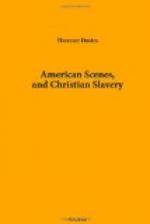In the evening Dr. Hawes accompanied me into the pulpit, and took the introductory part of the service. Most of the professors and students were present. It was a fine, though formidable, opportunity to plead the cause of the despised and oppressed sons of Afric before an audience of so much learning and intelligence. What a contrast! In 1742 the students were forbidden to attend the meetings of this church; and it was partly for once disobeying this prohibition, in order to hear the Rev. Gilbert Tennent, that David Brainerd was expelled from the college.
Nor were the sentiments I uttered new in this place. Nearly 60 years have rolled away since Jonathan Edwards the younger preached here a sermon, afterwards published by request, on the injustice and impolicy of the slave-trade and slavery,—a sermon which in these days would be called by many not merely abolitionism but incendiarism.
On Monday morning we were taken to see the cemetery, outside of the city. Formerly the Green was used as a burying-ground; but in the latter part of last century this field of ten acres was levelled and inclosed for the purpose; and in 1821 the monuments, with the exception of the humble stones of the three judges, were removed hither. The broken tablets and half-legible inscriptions, which constituted the memorials of the fathers and founders of this colony, were peculiarly interesting. On the 18th of April, 1638, those men kept their first Sabbath here. The people assembled under a large spreading oak, and Mr. Davenport, their pastor, preached to them from Matt. iv. 1: “Then was Jesus led up of the Spirit into the wilderness to be tempted of the devil.” His subject was the temptations of the wilderness; and he recorded the remark, that he had enjoyed “a good day.” The following year they met in a large barn, and in a very solemn manner proceeded to lay the foundation of their civil and religious polity. Mr. Davenport introduced the business with a sermon on “Wisdom hath builded her house; she hath hewn out her seven pillars.” The most ancient record of this event is a curiosity in the history of civil government. It thus begins:—“The 4th day of the 6th moneth, called June, all the free planters assembled together in a general meetinge, to consult about settling civil government according to God, and about the nomination of persons that may be found by consent of all fittest in all respects for the foundation work of a church, which was to be gathered in Quinipiack [the Indian name of the place]. After sollemne invocation of the name of God in prayer,” &c., they resolved—Alas! for that resolve! it admitted a wrong principle, and was productive, for more than 150 years, of the most withering and blighting effect upon that religion which they aimed to foster—they resolved among other things, “That church members only shall be free burgesses; and that they only shall chuse magistrates and officers among themselves, to have the power of transacting all publique civil affairs of this plantation,” &c.




